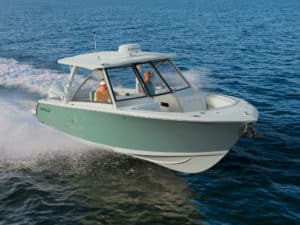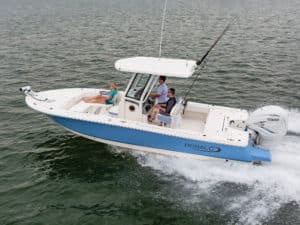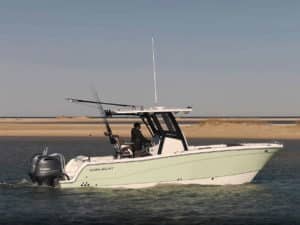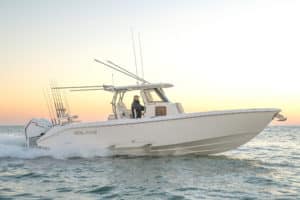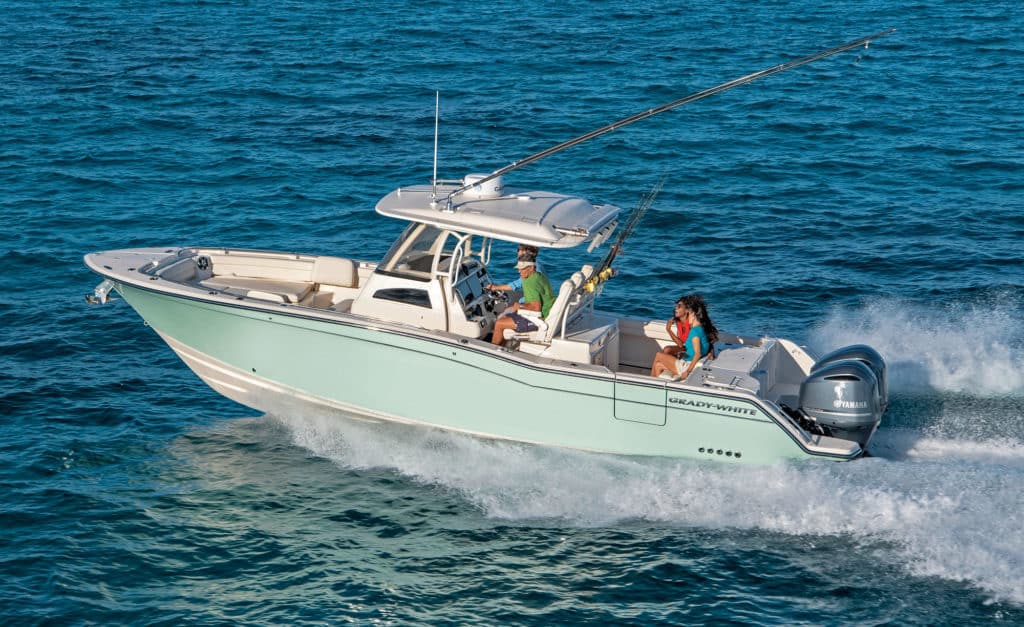
The afternoon forecast for the upper Chesapeake Bay called for stiff breezes and heavy showers. But during this early June Yamaha media event out of St. Michaels, Maryland, we had already committed to running six variously powered test boats in the morning, before heading out to jig stripers aboard the new Grady-White Canyon 326.
Thankfully, the rains held off, although the wind still violently chopped the bay’s surface as seven of us piled aboard the 32-footer with Capt. Shannon Pickens. The conditions and crowd could have dampened our enthusiasm had we been aboard a lesser boat. But for the stable, comfortable, well-appointed 326, this was child’s play.
First Impressions
The full-height windshield created a barrier to the full force of those warm afternoon gusts. In fact, Grady designed the width of the three-across helm seating so that the entire unit tucks neatly behind the protective structure of the console. Fresh air still circulates well, but it doesn’t rip the hat from your head at speed.
The superstructure for the standard hardtop also fits inside the windshield’s breadth, clearing and expanding the port and starboard walkways.
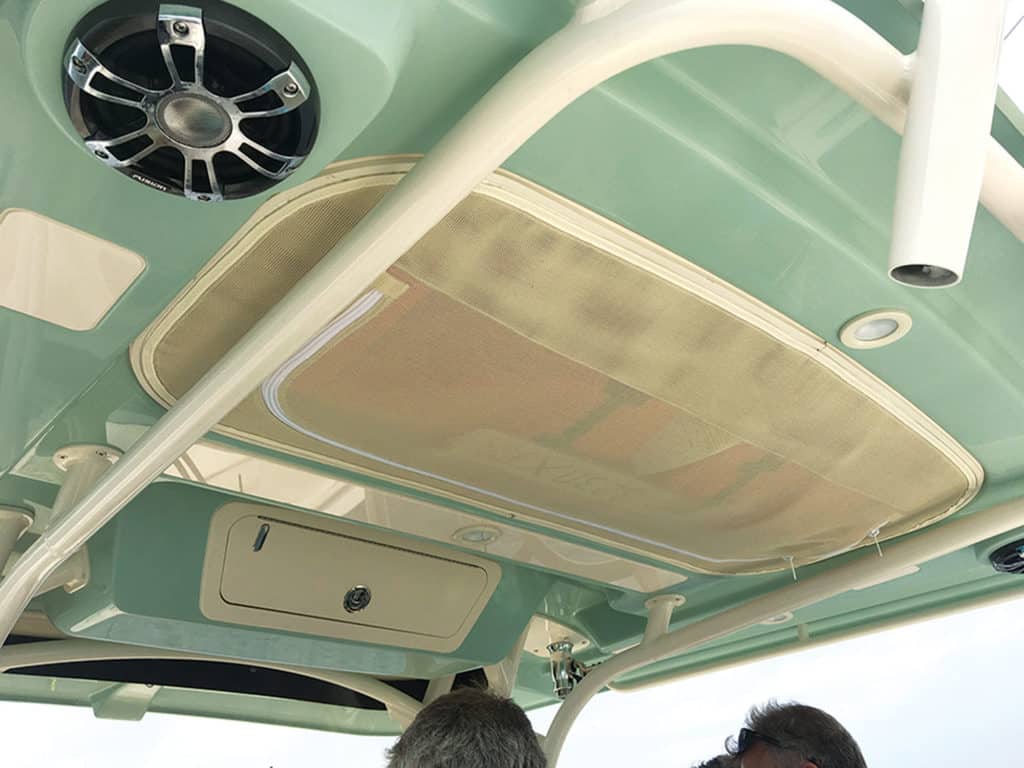
As Pickens cruised toward the Miles River in search of some fish–holding ledges, the 326 made easy work of the chop. I settled into one of the helm seats; all easily adjust fore and aft, and feature flip-up bolsters and armrests and flip-down footrests. Several of our crew opted for the foldaway aft bench.
I studied the twin 17-inch Garmin multifunction displays as Pickens navigated north and west. I also noticed a clever and handy fiddled storage tray atop the console. Grady covered the surface with a woven vinyl to keep gear from sliding and to help cut glare.
My test boat, powered by twin Yamaha F300s, came with the optional Helm Master system and its joystick control. Pickens would soon employ the system’s Drift Point function once we found fertile ground.
On the Drift
Pickens circled an oyster pile, where he marked heavy concentrations of bait. However, he said that recent rainfall levels had made jigging these post-spawn resident stripers a challenge. Nearby charter boats trolled to find fish, but we stuck with our plan.
Pickens first tried putting the boat in Fish Point mode, which locks its position—in this case, over the structure. However, the strong current kept our 1-ounce jigs from holding bottom. He switched to Drift Point, which maintains heading while drifting, so we made several passes over the oyster pile.
Drift Point allowed all seven of us to fish along the starboard side of the boat. The Grady’s 10-foot-9-inch beam and its encircling coaming pads made it ever so comfortable. Even with all that weight on one side, the boat remained stable.
Although we could clearly see signs of life on the fish-finder screen, we couldn’t interest the stripers in our offerings. Pickens moved from spot to spot, hoping to find hungry fish.
Forward Features
While we waited for the bite to turn on, I toured the 326 bow to stern. Inside the bow locker, I found a through-the-stem anchor roller and a standard windlass, which can be controlled from the bow or the helm. Atop that locker, a broad forward platform provides plenty of room to throw a cast net.
The port and starboard bow loungers plus an optional insert (that can double as a table) create a larger, more protected casting platform or a sun pad. The forward loungers top a pair of 45-gallon overboard-draining fish boxes, and come with bolstered backrests that hinge outward along the inwales when not in use.
The heavily cushioned forward -console bench adds more comfortable seating at the bow. Six cup holders provide plenty of accessible nests for cold drinks or cellphones. When it’s time to fish, four gunwale rod holders at the bow give anglers options for fishing kites or spreading out live baits on a drift.
Extra Amenities
Below the console lies a mini cabin with a cherry-and-holly sole, a stainless sink, a vanity with full mirror, a Vacuflush head, vertical storage for four rods, storage drawers, a bulk-storage locker and a cubby for four plastic tackle boxes.
Aft of the helm seats, a rigging -station with a freshwater sink and fish box comes standard. Anglers can opt to plumb the 38-gallon box as a livewell—in addition to the standard 32-gallon tank in the aft port corner—or add a grill and refrigerator.
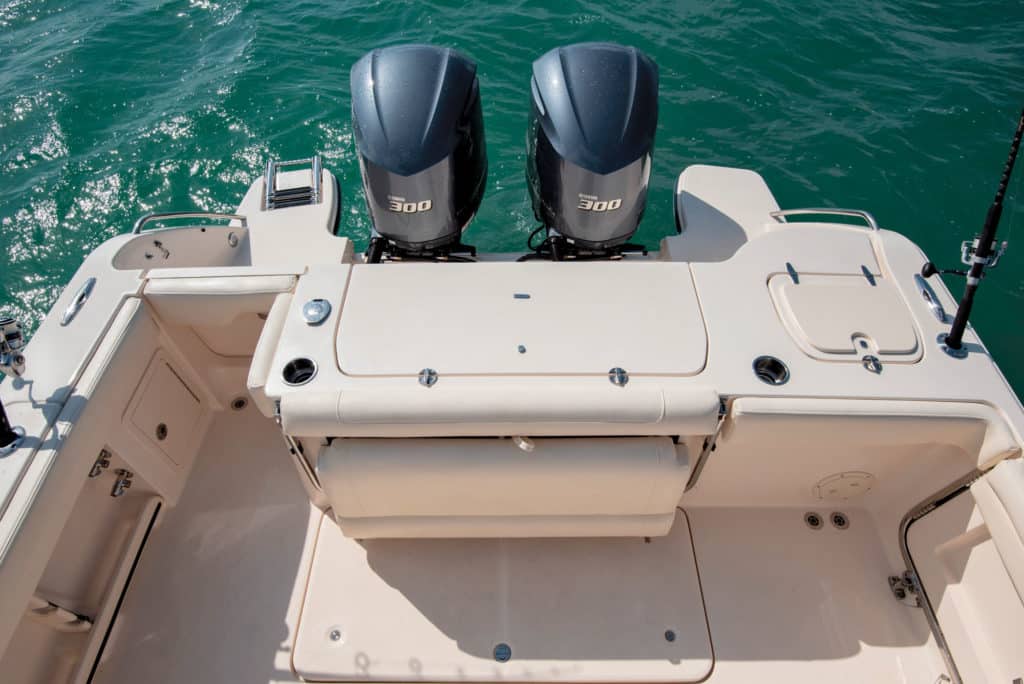
At the transom, anglers will find an 80-gallon insulated fish box on centerline and a tuna door to starboard. The door gives anglers access to a broad swim platform flanked by extended decks port and starboard for boarding or working a fish around the outboards.
For additional boarding ease or to land or release big fish, Grady added a dive door on the port side of the cockpit. Top that off with more than enough vertical and horizontal rod storage, and this is one well-appointed fish boat.
Successful Finish
About the time we thought our arms would give out, we found some willing bass. We lowered our weighted jigs to the bottom and caught schoolies on just about every drop. Keeping count became competitive.
Unfortunately, a tight schedule cut short the fun, and we headed back to the docks at the Inn at Perry Cabin. With so many people aboard, I opted to use the performance statistics gathered by Yamaha. But I could tell, even with the load, that the twin F300s popped the 326 onto plane in negligible time.
Yamaha lists a time to 30 mph of 6.87 seconds, and a top speed of 49.7 mph at 6,000 rpm, turning 15½‑by-17 Saltwater Series II SDS props. Best fuel economy—1.62 mpg—occurs at 28.1 mph and 3,500 rpm.
Turns proved effortless with -manageable centrifugal force, and the boat backs easily in both directions. Grady says the boat will run 14 mph on one engine, should that ever become necessary.
Read Next: Grady-White Canyon 306 First Glance
We dropped to idle outside the small harbor, and Pickens used the joystick to nestle us next to a pier.
As I disembarked, I felt a sense of ease. This vessel accommodated seven anglers, kept all of us and our gear dry (and happy) on a scruffy day, and always felt safe, solid, and comfortable at speed or on a drift. Those are the hallmarks of a well-built 32-footer.
Performance
Power: Twin Yamaha F300s
Load: Two adults, 164 gal. fuel, gear
Top Speed: 49.7 mph @ 6,000 rpm
Time to 30 MPH: 6.87 sec.
Best MPG: 1.62 mpg @ 28.1 mph (3,500 rpm)
Hull
LOA: 33 ft. 1 in. (w/ swim platforms)
Beam: 10 ft. 9 in.
Deadrise: 20 deg. w/ SeaV2 progression
Dry Weight: 8,500 lb. (w/o engines)
Draft: 2 ft.
Fuel: 327 gal.
Max Power: 700 hp
MSRP: $304,245 (base w/ twin Yamaha F300s, Helm Master)
Grady-White Boats
Greenville, NC
252-752-2111

